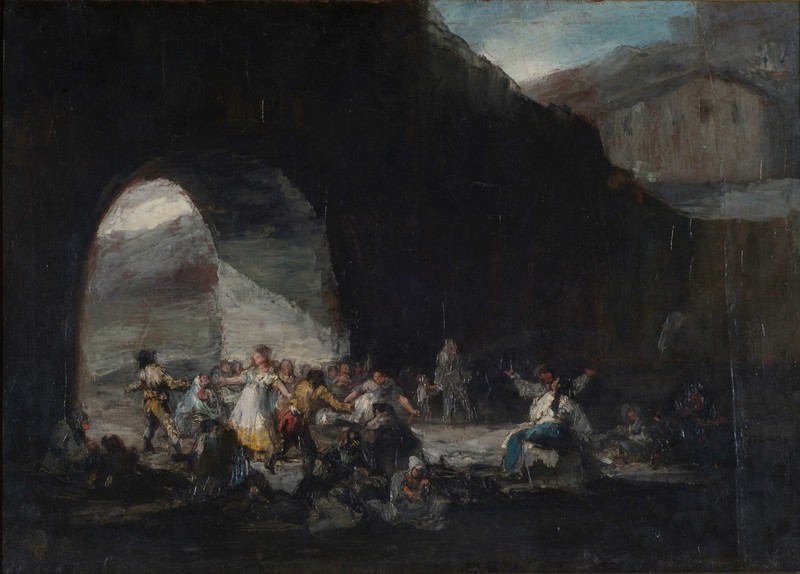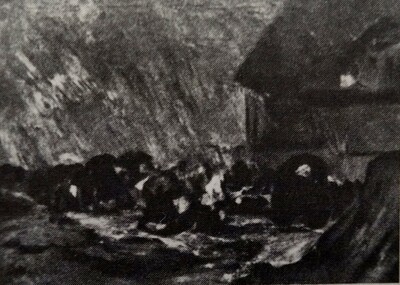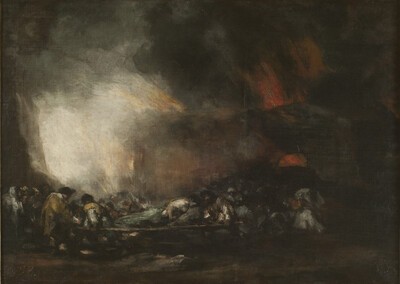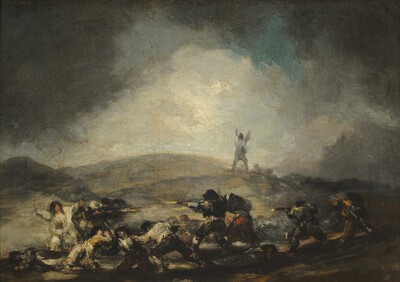- Cronología
- Ca. 1808 - 1812
- Ubicación
- Buenos Aries National Museum of Fine Arts, Buenos Aires, Argentina
- Dimensiones
- 72 x 100 cm
- Técnica y soporte
- Oil on canvas
- Reconocimiento de la autoría de Goya
- Undisputed work
- Titular
- National Museum of Fine Arts, Argentina
- Ficha: realización/revisión
- 16 May 2010 / 15 Jun 2023
- Inventario
- (2561)
- Otros títulos:
-
Popular Dance (Baile popular)
Carnival Scene (Escena de carnaval)
X.28
The first information on these works was published by the Count de la Viñaza in 1887, who recorded them in the Madrid collection of Eustaquio López, which was sold in 1866. According to Juan Corradini (1965), in 1886 Miguel Cané, the Argentine ambassador to Spain, on the advice of the Duke of Alba, bought six paintings by Goya, including The Fire and War Scene, as well as Procession of Discipliners, commissioned by Gabriel Larsen del Castaño; Popular Feast, bought by Parmenio T. Piñero, and two paintings acquired by the Jockey Club of Buenos Aires.
In 1907, Popular Feast entered the Museum through the Piñero bequest. The remaining three were in the possession of the Ugarte family, who auctioned them in 1954, at which time doubts again arose as to their authorship. They were acquired by Horacio Acevedo with the intention of donating them to the MNBA, where they entered in 1958 by donation of his brothers Carlos Alberto, Arturo and Eduardo Acevedo.
The inscription X.28 that appears in this painting ties it to three others by Goya, Bandit Scene, Festivities underneath a Bridge and The Hurricane which are all mentioned in the inventory made in 1812, following the death of Goya's wife.
Beneath the arch of a bridge, a festive scene is taking place, with a group of people who have gathered to dance, talk and play music.
The compositional arrangement employed here by Goya coincides in a number of ways with that used in Children Playing at Bullfighting. In both works, the artist has painted a rounded arch on the left-hand side and the light enters the scene through this archway, illuminating some figures whilst leaving others in shadow. This method of arranging the composition can also be seen in Interior of a Prison.
In the present canvas, the light leads our eye to the female figure who is dancing slightly off-centre, on the left-hand side. She is dressed in white, with her arms outstretched, and is facing a man, her dancing partner. The light also highlights a seated figure, also dressed in white, to the right of the scene, who appears to be watching the two dancing figures. This part of the painting bears some similarities to Goya's Masked Dance. In actual fact, this other work appears to be based on a detail of Festivities underneath a Bridge: in it, the artist has concentrated on the female figure dressed in white who is dancing with her arms raised in front of a man, and has set the scene underneath another rounded arch.
-
Ciento veinte años de pintura española 1810-1930Museo Nacional de Bellas ArtesBuenos Aires1991fig. p. 179
-
Arte español retrospectivoNosotrosBuenos Aires1939pp. 101-104.
-
Don Francisco de Goya y LucientesBuenos AiresPoseidón1942p. 68
-
La pintura en España (siglos XIX y XX)Buenos Aires1947p. 13, fig. 3
-
Vie et ouvre de Francisco de GoyaParísOffice du livre1970p. 265, cat. 949
-
BarcelonaPolígrafa1970vol. I, pp. 356 y 357, cat. 612
-
L’opera pittorica completa di GoyaMilanRizzoli1974p. 125, cat. 530
-
Catálogo de pintura española en Buenos Aires,Universidad de Oviedo - Universidad de Buenos Aires1997pp. 87-88



